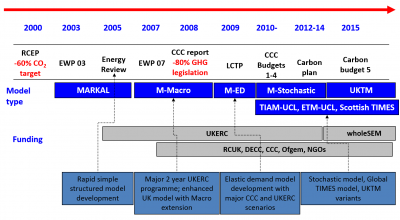NOTE: UK MARKAL has been superseded by the UK TIMES model.
The UK MARKAL model was originally developed to provide insights for the Energy White Paper 2003. It was adopted and completely revised by the UCL Energy Systems team in 2005 and was under constant development until 2012. The development of the original model was funded by the UK government but the current academic version was developed and supported primarily by the UK Energy Research Centre. The evolution of the UK MARKAL over time is explored in a paper on model archaeology.
UK MARKAL is a multi-time period linear optimisation model. Its simplest formulation is to minimise discounted energy systems cost, under a wide variety of physical and policy constraints. This minimisation takes into account evolving costs and characteristics of resources, infrastructures, technologies, taxes and conservation measures - to meet energy service demands; under a range of physical and policy constraints.
MARKAL is a very large model, with 1500 technology types, 250 energy carriers plus constraints, taxes, emissions and other model parameters. The model has well over ½ million data elements.
MARKAL portrays the entire energy system from imports and domestic production resources (fossil and renewable), through fuel processing and supply (e.g., refining, bio-processes), explicit representation of infrastructures (e.g., gas pipelines), conversion of fuels to secondary energy carriers (including electricity, heat and hydrogen), end-use technologies (residential, commercial, industry, transport, agricultures, non-energy), and energy service demands (at a sub-sectoral level) for the entire UK energy system.
| UK MARKAL versions | |
| Standard | Assumes inelastic energy service demands (i.e. consumers do not alter their demands for energy in response to changes in the price of supplying that energy) |
| Macro | Hybrid energy systems/macroeconomic model that was used to calculate the impact of decarbonisation on UK GDP growth |
| Elastic Demand | Assumes elastic energy service demands (i.e. consumers vary their demands for energy in response to changes in the price of supplying that energy) |
| Stochastic | Relaxes the assumptions of perfect foresight given underlying uncertainties |
| Spatial | Multi-region model of the UK to explicitly analyse new supply-demand-infrastructure combinations 2-region model to examine devolved Scottish energy policy |
| Temporal | Increases temporal disaggregation to better understand the impacts of electricity peaking |
Do you have any questions about UK MARKAL? If they are not answered in the UK MARKAL FAQ then please contact Paul Dodds.
Model summary
| Type: | Bottom-up, technology-rich cost optimisation |
| Purpose: | Decarbonisation pathways, technology assessment |
| Policy impact: | 2003 White Paper; 2007 White Paper; CCC initial report; CCC and DECC fourth carbon budget reports |
| Spatial scale: | UK single region |
| Temporal scale: | 3 seasons (summer, intermediate, winter), 2 intraday (day, night) |
| Main contact: | Paul Dodds |
| Other contacts: | Neil Strachan, Gabrial Anandarajah |
Influence on UK government policy
UK MARKAL has had a profound influence on UK decarbonisation policy as summarised in the diagram below.
Studies using UK MARKAL underpinned the Energy White Papers (EWP) in 2003 and 2007, the Climate Change Bill 2008, the first report of the Committee on Climate Change (CCC) and the CCC and DECC fourth carbon budget reports.

Documentation
UK MARKAL documentation is available here.
Publications
Numerous peer-reviewed publications have been based on analyses using UK MARKAL and can be viewed here.
Accessing the model
UK MARKAL is used by several UK universities, a consultancy (Ricardo-AEA) and the UK Department of Energy and Climate Change.
All users are required to sign a Memorandum of Understanding that governs use of the model. Please contact Neil Strachan for more details.
 Close
Close

